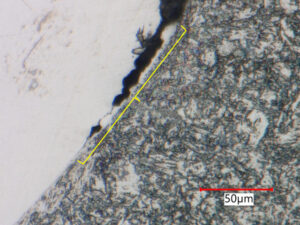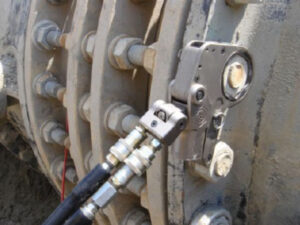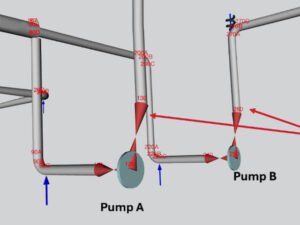In today’s rapidly evolving technological landscape, ensuring the safety and reliability of electrical systems is paramount. Electrical failures can lead to unscheduled downtime, damage to equipment, and even pose serious risks to personnel safety. To mitigate these risks, facilities must prioritize regular audits and inspections of electrical systems. One such critical audit is outlined in NFPA 70B, which provides guidelines for maintaining the safety and reliability of electrical equipment. In this article, we’ll explore the significance of performing electrical safety and reliability audits and the benefits they offer to both employees and organizations.
Electrical reliability has been a subject of discussion since facilities started using electricity to power their processes. As expectations continue to rise, the risks and potential losses associated with an unscheduled outage grow exponentially.
Understanding NFPA 70B:
NFPA 70B, the Standard for Electrical Equipment Maintenance, was recently changed from a recommended practice to a standard. It outlines comprehensive guidelines for the maintenance, inspection, and testing of electrical systems and equipment. The primary objective of NFPA 70B is to ensure the continued safe and reliable operation of electrical systems by identifying and addressing potential issues before they escalate into serious problems.
The Importance of Electrical Audits:
Compliance with regulations: Compliance with requirements in NFPA 70 (NEC), NFPA 70B, and NFPA 70E, along with OSHA PSM standards, is essential for ensuring regulatory compliance and meeting legal obligations. Non-compliance can result in penalties, fines, or even legal liabilities in the event of accidents or injuries caused by electrical failures. The question is often asked, “When is this enforceable?” and “Who enforces this?” Of course, the Authority Having Jurisdiction (AHJ) and OSHA are both obvious answers. However, the first step towards compliance is appointing a dedicated Electrical Maintenance Program (EMP) Coordinator who oversees implementation of the program. It’s unknown how non-compliance could affect insurance premiums, but it is safe to assume that if insurers are able to link non-compliance to an incident, premiums would be adversely affected.
Risk mitigation: Electrical failures can have severe consequences, including equipment damage, unscheduled production downtime, and safety hazards. Electrical safety and reliability audits help identify potential risks and vulnerabilities in electrical systems, allowing facilities to implement and schedule preventive measures to effectively mitigate these risks. The condition-based maintenance program detailed in NFPA 70B helps to reduce unnecessarily onerous preventative maintenance schedules. Instead, NFPA 70B compliance helps facilities focus on investing in improved efficiency, safety, and useful lifespan of electrical equipment.
Enhanced safety: Safety is a top priority in any production environment. Audits help identify safety hazards such as loose connections, inadequate/damaged insulation, or outdated equipment. By proactively addressing these issues, you can create a safer working environment for personnel and reduce the risk of electrical accidents or fires.
Improved reliability: Electrical system failures can disrupt operations and lead to costly downtime. By conducting regular audits as per stated requirements in NFPA 70B, you can identify and rectify potential issues that could compromise the reliability of electrical systems. This proactive approach helps minimize unplanned downtime and enhances overall system reliability.
Optimal performance: Proper maintenance and inspection of electrical equipment are essential for ensuring optimal performance. NFPA 70B audits help identify inefficiencies, voltage fluctuations, or other issues that could affect the performance of electrical systems. By promptly addressing these issues, engineers can optimize the performance of electrical equipment and extend its lifespan.
Benefits of Electrical and Safety Audits:
Cost savings: Proactive maintenance and timely identification of potential issues can help organizations save significant costs associated with emergency repairs, downtime, and equipment replacement. Audits enable engineers to address problems before they escalate, resulting in long-term cost savings.
Increased equipment lifespan: Regular maintenance, inspection, and testing as per NFPA 70B guidelines can extend the lifespan of electrical equipment. By identifying and addressing issues such as corrosion, overheating, and mechanical wear, engineers can prevent premature equipment failure and maximize its operational lifespan.
Regulatory compliance: Compliance with these standards demonstrates a commitment to electrical safety and regulatory compliance. Organizations that adhere to these standards are more likely to meet regulatory requirements and avoid potential legal and financial consequences associated with non-compliance.
Compliance Flowchart:

- Designate an Electrical Maintenance Program (EMP) Coordinator
- Coordinator Training: The designated coordinator should undergo NFPA 70B training and participate in annual audits and evaluations to ensure strict adherence to maintenance and testing procedures.
- Collaboration with Safety Programs: Work closely with existing safety programs, especially the Electrical Safety Program, to integrate EMP tasks within your current safety framework.
- Maintainability in New Designs: Develop and implement processes that emphasize maintainability in new installations.
- Assess Electrical Infrastructure and Equipment
- Regular Inspections: Conduct regular inspections of electrical equipment and use the results to refine maintenance tasks within the EMP.
- Documentation Practices: Evaluate and enhance current documentation practices to ensure systematic record-keeping. This will make it easier to plan future maintenance and retrieve necessary records.
- Compliance Analysis: Analyze and document existing electrical systems and maintenance procedures to identify non-compliant areas and target them for corrective measures.
- Equipment Categorization: Use NFPA 70B guidelines to categorize electrical equipment by its condition and operational criticality, aiding in the prioritization of maintenance tasks and resource allocation.
- Update One-Line Diagrams and Other Studies Older Than Five Years
- Regular Updates: As per NFPA 70B Chapter 6, update one-lines, short-circuit, coordination, and arc flash studies every five years or any time a significant change has been made to your electrical power distribution/load.
- Documentation Storage: Ensure that personnel, equipment, and maintenance records are stored systematically and can be retrieved efficiently.
- Efficient Retrieval: If records are difficult to retrieve, investigate and implement a more efficient retrieval process.
- Determine Maintenance Intervals and Scope Based on Assessments
- Follow Manufacturer Recommendations: Adhere to maintenance intervals suggested by equipment manufacturers.
- Refer to NFPA 70B: In the absence of manufacturer recommendations, use NFPA 70B Chapter 9 as a guideline.
- Predictive Techniques: Employ continuous monitoring and predictive maintenance techniques to anticipate issues and schedule proactive maintenance.
- Perform Any Remediation Identified by Assessments
- Prioritization: Rank remediation tasks by urgency, safety risks, and operational impact, prioritizing critical equipment and high-risk safety items.
- Scheduled Downtime: Plan necessary downtime to address identified tasks.
- Training and Communication: Ensure the team is trained on the new NFPA 70B standards and understands the updated maintenance procedures.
- Record Keeping: Maintain detailed records of all remediation actions and services.
- Update EMP to Verify Compliance
- Record All Procedures: Document all inspections and maintenance activities. Effective record-keeping is crucial for planning future maintenance.
- Audit Your EMP Every 5 Years or Less
- Comprehensive Audits: Include all maintenance procedures, schedules, documentation, and other relevant information.
- Standard Comparison: Compare the EMP with the current NFPA 70B standard to identify areas for improvement.
- Implement Changes: Adjust maintenance procedures, refine documentation practices, and update schedules based on audit findings.
- Document Improvements: Record all changes made as part of the continual improvement process.
- Digitize/Digitalize
- Electronic Documentation: Save and back up all documentation electronically to reduce the risk of loss. For example, electronically managing the spare parts list for your facility will enable a more proactive management, ensuring the right parts are in stock and reducing extended downtime due to not having critical spare parts on hand.
- Planned Upgrades: Consider planned upgrades to electrical equipment for enhanced connectivity and intelligence. Connected or “intelligent” equipment communicates with your DCS, providing early alerts and warnings about potential issues.
Conclusion:
A recurring theme in the above article is ensuring all required documentation is organized and easily accessible.
Electrical safety and reliability audits are vital for ensuring the performance and safety of your entire facility. By following the guidelines set out in NFPA 70B, NFPA 70E, and the NEC, facilities can identify potential risks early, improve safety measures, and optimize the performance of electrical equipment. These audits are not just about compliance; they offer significant long-term benefits, including cost savings and enhanced operational efficiency. Committing to these practices to uphold standards of excellence will ensure the continued reliability of each processing facility.
If you have any questions for the author, please submit the form below:





